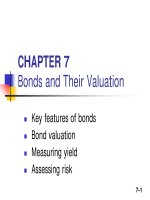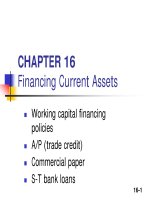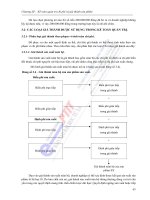International Financial Management phần 4 pps
Bạn đang xem bản rút gọn của tài liệu. Xem và tải ngay bản đầy đủ của tài liệu tại đây (889.85 KB, 10 trang )
About the Author
Jeff Madura is the SunTrust Bank Professor of Finance at Florida Atlantic University. He
received his Ph.D. from Florida State University and has written several highly regarded
textbooks, including Financial Markets and Institutions. His research on international
finance has been published in numerous journals, including the Journal of Financial and
Quantitative Analysis; Journal of Money, Credit and Banking; Financial Management;
Journal of Financial Research; and Financial Review. He has received multiple awards for
excellence in teaching and research and has served as a consultant for international banks,
securities firms, and other multinational corporations. He has also served as director
for the Southern Finance Association and Eastern Finance Association and as presi-
dent of the Southern Finance Association.
xxix
Copyright 2010 Cengage Learning. All Rights Reserved. May not be copied, scanned, or duplicated, in whole or in part. Due to electronic rights, some third party content may be suppressed from the eBook and/or eChapter(s).
Editorial review has deemed that any suppressed content does not materially affect the overall learning experience. Cengage Learning reserves the right to remove additional content at any time if subsequent rights restrictions require it.
Licensed to:
iChapters User
Copyright 2010 Cengage Learning. All Rights Reserved. May not be copied, scanned, or duplicated, in whole or in part. Due to electronic rights, some third party content may be suppressed from the eBook and/or eChapter(s).
Editorial review has deemed that any suppressed content does not materially affect the overall learning experience. Cengage Learning reserves the right to remove additional content at any time if subsequent rights restrictions require it.
Licensed to:
iChapters User
APPENDIX A
Answers to Self-Test Questions
CHAPTER 1
1. MNCs can capitalize on comparative advantages (such as a technology or cost of
labor) that they have relative to firms in other countries, which allows them to penetrate
those other countries’ markets. Given a world of imperfect markets, comparative advan-
tages across countries are not freely transferable. Therefore, MNCs may be able to capi-
talize on comparative advantages. Many MNCs initially penetrate markets by exporting
but ultimately establish a subsidiary in foreign markets and attempt to differentiate
their products as other firms enter those markets (product cycle theory).
2. Weak economic conditions or unstable po litical conditions in a foreign country
can reduce cash flows received by the MN C, or they can result in a higher required
rate of re turn f or the MNC. Either of these effects re sults in a lower valuation of
the MNC.
3. First, there is the risk of poor economic conditions in the foreign country. Second,
there is country risk, which reflects the risk of changing government or public attitudes
toward the MNC. Third, there is exchange rate risk, which can affect the performance
of the MNC in the foreign country.
CHAPTER 2
1. Each of the economic factors is described, holding other factors constant.
a. Inflation. A relatively high U.S. inflation rate relative to other countries can make
U.S. goods less attractive to U.S. and non-U.S. consumers, which results in fewer U.S.
exports, more U.S. imports, and a lower (or more negative) current account balance.
A relatively low U.S. inflation rate would have the opposite effect.
b. National income. A relatively high increase in the U.S. national income (compared
to other countries) tends to cause a large increase in demand for imports and can cause
a lower (or more negative) current account balance. A relatively low increase in the U.S.
national income would have the opposite effect.
c. Exchange rates. A weaker dollar tends to make U.S. products cheaper to non-U.S.
firms and makes non-U.S. products expensive to U.S. firms. Thus, U.S. exports are
expected to increase, while U.S. imports are expected to decrease. However, some con-
ditions can prevent these effects from occurring, as explained in the chapter. Normally,
a stronger dollar causes U.S. exports to decrease and U.S. imports to increase because it
635
Copyright 2010 Cengage Learning. All Rights Reserved. May not be copied, scanned, or duplicated, in whole or in part. Due to electronic rights, some third party content may be suppressed from the eBook and/or eChapter(s).
Editorial review has deemed that any suppressed content does not materially affect the overall learning experience. Cengage Learning reserves the right to remove additional content at any time if subsequent rights restrictions require it.
Licensed to:
iChapters User
makes U.S. goods more expensive to non-U.S. firms and makes non-U.S. goods less ex-
pensive to U.S. firms.
d. Government restrictions. When the U.S. government imposes new barriers on imports,
U.S. imports decline, causing the U.S. balance of trade to inc rease (or b e less negative) . When
non-U.S. governments impose new barriers on impor ts from the United St ates, the U.S. bal-
ance of trade may decrease (or be m ore negative). When governments remove trade barriers,
the opposite eff ects are expected.
2. When the United States imposes tariffs on imported goods, foreign countries may
retaliate by imposing tariffs on goods exported by the United States. Thus, there is a de-
cline in U.S. exports that may offset any decline in U.S. imports.
3. A global recession might cause governments to impose trade restrictions so that they
can protect local firms from intense competition and prevent additional layoffs within
the country. However, if other countries impose more barriers in retaliation, this strategy
could backfire.
CHAPTER 3
1. ($.80 – $.784)/$.80 = .02, or 2%
2. ($.19 – $.188)/$.19 = .0105, or 1.05%
3. MNCs use the spot foreign exchange market to exchange currencies for immediate
delivery. They use the forward foreign excha nge market and the currency futures mar-
ket to lock in the exchange rate at which currencies will be exchanged at a future point
in time. They use the currency options market when they wish to lock in the maxi-
mum (minimum) amount to be paid (received ) in a future currency transaction but
maintain flexibility in the event of favorable exchange rate movements.
MNCs use the Eurocurrency market to engage in short-term investing or financing or
the Eurocredit market to engage in medium-term financing. They can obtain long-term
financing by issuing bonds in the Eurobond market or by issuing stock in the interna-
tional markets.
CHAPTER 4
1. Economic factors affect the yen’s value as follows:
a. If U.S. inflation is higher than Japanese inflation, the U.S. demand for Japanese goods
may increase (to avoid the higher U.S. prices), and the Japanese demand for U.S. goods may
decrease (to avoid the higher U.S. prices). Consequently, there is upward pressure on the
value of the yen.
b. If U.S. interest rates increase and exceed Japanese interest rates, the U.S. demand for
Japanese interest-bearing securities may decline (since U.S. interest-bearing securities
are more attractive), while the Japanese demand for U.S. interest-bearing securities may
rise. Both forces place downward pressure on the yen’s value.
c. If U.S. national income increases more than Japanese national income, the U.S. demand
for Japanese goods may increase more than the Japanese demand for U.S. goods. Assuming
that the change in national income levels does not affect exchange rates indirectly through
effects on relative interest rates, the forces should place upward pressure on the yen’s value.
d. If government controls reduce the U.S. demand for J apanese goods, they place
downward pressure on the yen’s value. If the con trols r educe the Japan ese demand
for U.S. goods, they place upward pressure on the yen’svalue.
636 Appendix A: Answers to Self-Test Questions
Copyright 2010 Cengage Learning. All Rights Reserved. May not be copied, scanned, or duplicated, in whole or in part. Due to electronic rights, some third party content may be suppressed from the eBook and/or eChapter(s).
Editorial review has deemed that any suppressed content does not materially affect the overall learning experience. Cengage Learning reserves the right to remove additional content at any time if subsequent rights restrictions require it.
Licensed to:
iChapters User
The opposite scenarios of those described here would cause the expected pressure to be
in the opposite direction.
2. U.S. capital flows with Country A may be larger than U.S. capital flows with
Country B. Therefore, the change in the interest rate differential has a larger effect on
the capital flows with Country A, causing the exchange rate to change. If the capital flows
with Country B are nonexistent, interest rate changes do not change the capital flows and
therefore do not change the demand and supply c onditions in the foreign exchange market.
3. Smart Banking Corp. should not pursue the strategy because a loss would result, as
shown here.
a. Borrow $5 million.
b. Convert $5 million to C$5,263,158 (based on the spot exchange rate of $.95 per C$).
c. Invest the C$ at 9 percent annualized, which represents a return of .15 percent over
6 days, so the C$ received af ter 6 days = C$5,271,053 (computed as C$5,263,158 ×
[1 + .0015]).
d. Convert the C$ received back to U.S. dollars after 6 days: C$5,271,053 = $4,954,789
(based on anticipated exchange rate of $.94 per C$ after 6 days).
e. The interest rate owed on the U.S. dollar loan is .10 percent over the 6-day period.
Thus, the amount owed as a result of the loan is $5,005,000 [computed as $5,000,000 ×
(1 + .001)].
f. The strategy is expected to cause a gain of $4,954,789 – $5,005,000 = –$50,211.
CHAPTER 5
1. The net profit to the speculator is –$.01 per unit.
The net profit to the speculator for one contract is –$500 (computed as –$.01 ×
50,000 units).
The spot rate would need to be $.66 for the speculator to break even.
The net profit to the seller of the call option is $.01 per unit.
2. The speculator should exercise the option.
The net profit to the speculator is $.04 per unit.
The net profit to the seller of the put option is –$.04 per unit.
3. The premium paid is higher for options with longer expiration dates (other things
being equal). Firms may prefer not to pay such high premiums.
CHAPTER 6
1. Market forces cause the demand and supply of yen in the foreign exchange market
to change, which causes a change in the equilibrium exchange rate. The central banks
could intervene to affect the demand or supply conditions in the foreign exchange mar-
ket, but they would not always be able to offset the changing market forces. For exam-
ple, if there were a large increase in the U.S. demand for yen and no increase in the
supply of yen for sale, the central banks would have to increase the supply of yen in the
foreign exchange market to offset the increased demand.
2. The Fed could use direct intervention by selling some of its dollar reserves in exchange
for pesos in the foreign exchange market. It could also use indirect intervention by attempt-
ing to reduce U.S. interest rates through monetary policy. Specifically, it could increase the
U.S. money supply, which places downward pressure on U.S. interest rates (assuming that
Appendix A: Answers to Self-Test Questions 637
Copyright 2010 Cengage Learning. All Rights Reserved. May not be copied, scanned, or duplicated, in whole or in part. Due to electronic rights, some third party content may be suppressed from the eBook and/or eChapter(s).
Editorial review has deemed that any suppressed content does not materially affect the overall learning experience. Cengage Learning reserves the right to remove additional content at any time if subsequent rights restrictions require it.
Licensed to:
iChapters User
inflationary expectations do not change). The lower U.S. interest rates should discourage
foreign investment in the United States and encourage increased investment by U.S. inves-
tors in foreign securities. Both forces tend to weaken the dollar’s value.
3. A weaker dollar tends to increase the demand for U.S. goods because the price paid
for a specified amount in dollars by non-U.S. firms is reduced. In addition, the U.S. de-
mand for foreign goods is reduced because it takes more dollars to obtain a specified
amount in foreign currency once the dollar weakens. Both forces tend to stimulate the
U.S. economy and therefore improve productivity and reduce unemployment in the
United States.
CHAPTER 7
1. No. The cross exchange rate between the pound and the C$ is appropriate, based
on the other exchange rates. There is no discrepancy to capitalize on.
2. No. Covered interest arbitrage involves the exchange of dollars for pounds. Assuming
that the investors begin with $1 million (the starting amount will not affect the final
conclusion), the dollars would be converted to pounds as shown here:
$1 million/$1.60 per £ = £625,000
The British investment would accumulate interest over the 180-day period, resulting in
£625,000 × 1.04 = £650,000
After 180 days, the pounds would be converted to dollars:
£650,000 × $1.56 per pound = $1,014,000
This amount reflects a return of 1.4 percent above the amount with which U.S. investors
initially started. The investors could simply invest the funds in the United States at
3 percent. Thus, U.S. investors would earn less using the covered interest arbitrage
strategy than investing in the United States.
3. No. The forward rate discount on the pound does not perfectly offset the i nterest
rate differential. In fact, the discount is 2.5 percent, which is larger than the interest
rate differential. U.S. investors do worse when attempting covered interest arbitrage
than when investing their funds in the United States because the interest rate ad-
vantage on the British investment is more than offset by the forward discount.
Further clarification may be helpful here. While the U.S. investors could not benefit
from covered interest arbitrage, British investors could capitalize on covered interest ar-
bitrage. While British investors would earn 1 percent interest less on the U.S. invest-
ment, they would be purchasing pounds forward at a discount of 2.5 percent at the end
of the investment period. When interest rate parity does not exist, investors from only
one of the two countries of concern could benefit from using covered interest arbitrage.
4. If t here is a discrepancy in the pr icing of a currency, one may capitalize on it by
using the various forms of arbitrage described in the chapter. As arbitrage occurs,
the exchange rates will be pushed toward their appropriate levels because arbitra-
geurs will buy an underpriced currency in the foreign exchange market (increase in
demand for currency places upward pressure on its value) and will sell an overpriced
currency in the foreign exchange market (increase in the supply of currency for sale
places downward pressure on its value).
5. The 1-year forward discount on pounds would become more pronounced (by about
1 percentage point more than before) because the spread between the British interest
rates and U.S. interest rates would increase.
638 Appendix A: Answers to Self-Test Questions
Copyright 2010 Cengage Learning. All Rights Reserved. May not be copied, scanned, or duplicated, in whole or in part. Due to electronic rights, some third party content may be suppressed from the eBook and/or eChapter(s).
Editorial review has deemed that any suppressed content does not materially affect the overall learning experience. Cengage Learning reserves the right to remove additional content at any time if subsequent rights restrictions require it.
Licensed to:
iChapters User
CHAPTER 8
1. IftheJapanesepricesrisebecauseofJapaneseinflation,thevalueoftheyenshould
decline. Thus, even though the importer might need to pay more yen, it would benefit
from a weaker yen value (it would pay fewer dollars for a given amount in yen). Thus,
there could be an offsetting effect if PPP holds.
2. Purchasing power parity does not necessarily hold. In our example, Japanese inflation
could rise (causing the importer to pay more yen), and yet the Japanese yen would not
necessarily depreciate by an offsetting amount, or at all. Therefore, the dollar amount to
be paid for Japanese supplies could increase over time.
3. High inflation will cause a balance-of-trade adjustment, whereby the United States will
reduce its purchases of goods in these countries, while the demand for U.S. goods by these
countries should increase (according to PPP). Consequently, there will be downward pres-
sure on the values of these currencies.
4.
e
f
¼ I
h
− I
f
¼ 3% − 4%
¼ −:01; or − 1%
S
tþ1
¼ Sð1 þe
f
Þ
¼ $:85½1 þð−:01Þ
¼ $:8415
5.
e
f
¼
1 þi
h
1 þi
f
− 1
¼
1 þ:06
1 þ:11
− 1
≅ −:045; or − 4:5%
S
tþ1
¼ Sð1 þ e
f
Þ
¼ $:90½1 þð−:045Þ
¼ $:8595
6. According to the IFE, the increase in interest rates by 5 percentage points reflects an
increase in expected inflation by 5 percentage points.
If the inflation adjustment occurs, the balance of trade should be affected, as Austra-
lian demand for U.S. goods rises while the U.S. demand for Australian goods declines.
Thus, the Australian dollar should weaken.
If U.S. investors believed in the IFE, they would not attempt to capitalize on higher Aus-
tralian interest rates because they would expect the Australian dollar to depreciate over time.
CHAPTER 9
1. U.S. 4-year interest rate = (1 + .07)
4
= 131.08%, or 1.3108. Mexican 4-year interest
rate = (1 + .20)
4
= 207.36%, or 2.0736.
p ¼
1 þ i
b
1 þ i
f
− 1 ¼
1:3108
2:0736
− 1
¼ −:3679; or −36:79%
Appendix A: Answers to Self-Test Questions 639
Copyright 2010 Cengage Learning. All Rights Reserved. May not be copied, scanned, or duplicated, in whole or in part. Due to electronic rights, some third party content may be suppressed from the eBook and/or eChapter(s).
Editorial review has deemed that any suppressed content does not materially affect the overall learning experience. Cengage Learning reserves the right to remove additional content at any time if subsequent rights restrictions require it.
Licensed to:
iChapters User
2. Canadian dollar
|$:80 − $:82|
$:82
¼ 2:44%
Japanese yen
|$0:12 − $:011|
$:011
¼ 9:09%
The forecast error was larger for the Japanese yen.
3. The forward rate of the peso would have overestimated the future spot rate because the
spot rate would have declined by the end of each month.
4. Semistrong-form efficiency would be refuted since the currency values do not adjust
immediately to useful public information.
5. The peso would be expected to depreciate because t he forward rate of the peso
would exhibit a discount (be less than the spot rate). Thus, the forecast derived
from the forward rate is less than the spot rate, which implies anticipated depr eci-
ation of the peso.
6. As the chapter suggests, forecasts of currencies are subject to a high degree of error.
Thus, if a project’s success is very sensitive to the future value of the bolivar, there is
much uncertainty. This project could easily backfire because the future value of the bo-
livar is very uncertain.
CHAPTER 10
1. Managers have more information about the firm’s exposure to exchange rate risk than
do shareholders and may be able to hedge it more easily than shareholders could. Share-
holders may prefer that the managers hedge for them. Also, cash flows may be stabilized
as a result of hedging, which can reduce the firm’s cost of financing.
2. The Canadian supplies would have less exposure to exchange rate risk because
theCanadiandollarislessvolatilethantheMexicanpeso.
3. The Mexican source would be preferable because the firm could use peso inflows
to make payments for material that is imported.
4. No. If exports are priced in dollars, the dollar cash flows received from exporting will
depend on Mexico’s demand, which will be influenced by the peso’svalue.Ifthepeso
depreciates, Mexican demand for the exports would likely decrease.
5. The earnings generated by the European subsidiaries will be translated to a smaller
amount in dollar earnings if the dollar strengthens. Thus, the consolidated earnings
of the U.S based MNCs will be reduced.
CHAPTER 11
1. Amount of A$ to be invested today = A$3,000,000/(1 + .12)
= A$2,678,571
Amount of U.S.$ to be borrowed to convert to A$ = A$2,678,571 × $.85
= $2,276,785
Amount of U.S.$ needed in 1 year to pay off loan = $2,276,785 × (1 + .07)
= $2,436,160
640 Appendix A: Answers to Self-Test Questions
Copyright 2010 Cengage Learning. All Rights Reserved. May not be copied, scanned, or duplicated, in whole or in part. Due to electronic rights, some third party content may be suppressed from the eBook and/or eChapter(s).
Editorial review has deemed that any suppressed content does not materially affect the overall learning experience. Cengage Learning reserves the right to remove additional content at any time if subsequent rights restrictions require it.
Licensed to:
iChapters User
2. The forward hedge would be more appropriate. Given a forward rate of $.81, Montclair
would need $2,430,000 in 1 year (computed as A$3,000,000 × $.81) when using a forward
hedge.
3. Montclair could purchase currency call options in Australian dollars. The option could
hedge against the possible appreciation of the Australian dollar. Yet, if the Australian dol-
lar depreciates, Montclair could let the option expire and purchase the Australian dollars
at the spot rate at the time it needs to send payment. A disadvantage of the currency call
option is that a premium must be paid for it. Thus, if Montclair expects the Australian
dollar to appreciate over the year, the money market hedge would probably be a better
choice since the flexibility provided by the option would not be useful in this case.
4. Even though Sanibel Co. is insulated from the beginning of a month to the end of the
month, the forward rate will become higher each month because the forward rate moves
with the spot rate. Thus, the firm will pay more dollars each month, even though it is
hedged during the month. Sanibel will be adversely affected by the consistent appreciation
of the pound.
5. Sanibel Co. could engage in a series of forward contracts today to cover the payments
in each successive month. In this way, it locks in the future payments today and does
not have to agree to the higher forward rates that may exist in future months.
6. A put option on SF2 million would cos t $60,000. If the spot rate of the SF reached
$.68 as expected, the put option would be exercised, which would yield $1,380,000
(computed as SF2,000,000 × $.69). Accounting for the premium costs of $60,000, the
receivables amount would conve rt to $1,320,000. If Hopkins re mains unhedged, it ex-
pects to receive $1,360,000 (computed as SF2,000,000 × $.68). Thus, the unhedged
strategy is preferable.
CHAPTER 12
1. Salem could attempt to purchase its chemicals from Canadian s ources. Then, if the
C$ depreciates, the reduction in dollar inflows resulting from its exports to Canada will
be partially offset by a reduction in dollar outflows needed to pay for t he Canadian imports.
An alternative possibility for Salem is to finance its business with Canadian dollars,
but this would probably be a less efficient solution.
2. A possible disadvantage is that Salem would forgo some of the benefits if the C$ appre-
ciated over time.
3. The consolidated earnings of Coastal Corp. will be adversely affected if the pound
depreciates because the British earnings will be translated into dollar earnings for the
consolidated income statement at a lower exchange rate. Coastal could attempt to
hedge its translation exposure by selling pounds forward. If the pound depreciates, it
will benefit from its forward position, which could help offset the translation effect.
4. This argument has no perfect solution. It appears that shareholders penalize the firm
for poor earnings even when the reason for poor earnings is a weak euro that has adverse
translation effects. It is possible that translation effects could be hedged to stabilize earn-
ings, but Arlington may consider informing the shareholders that the major earnings
changes have been due to translation effects and not to changes in consumer demand or
other factors. Perhaps shareholders would not respond so strongly to earnings changes if
they were well aware that the changes were primarily caused by translation effects.
5. Lincolnshire has no translation exposure since it has no foreign subsidiaries. Kalafa
has translation exposure resulting from its subsidiary in Spain.
Appendix A: Answers to Self-Test Questions 641
Copyright 2010 Cengage Learning. All Rights Reserved. May not be copied, scanned, or duplicated, in whole or in part. Due to electronic rights, some third party content may be suppressed from the eBook and/or eChapter(s).
Editorial review has deemed that any suppressed content does not materially affect the overall learning experience. Cengage Learning reserves the right to remove additional content at any time if subsequent rights restrictions require it.
Licensed to:
iChapters User
CHAPTER 13
1. Possible reasons may include
• More demand for the product (depending on the product)
• Better technology in Canada
• Fewer restrictions (less political interference)
2. Possible reasons may include
• More demand for the product (depending on the product)
• Greater probability of earning superior profits (since many goods have not been
marketed in Mexico in the past)
• Cheaper factors of production (such as land and labor)
• Possible exploitation of monopolistic advantages
3. U.S. firms prefer to enter a country when the foreign country’s currency is weak. U.S.
firms normally would prefer that the foreign currency appreciate after they invest their
dollars to develop the subsidiary. The executive’s comment suggests that the euro is too
strong, so any U.S. investment of dollars into Europe will not convert into enough euros
to make the investment worthwhile.
4. It may be easier to engage in a joint venture with a Chinese firm, which is already
well established in China, to circumvent barriers.
5. The government may attempt to stimulate the economy in this way.
CHAPTER 14
1. In addition to earnings generated in Jamaica, the NPV is based on some factors
not controlled by the firm, such as the expected host government tax on profits, the
withholding tax imposed by the host government, and the salvage value to be re-
ceived when the project is terminated. Furthermore, the exchange rate projections
will affect the estimates of dollar cash flows received by the parent as earnings are
remitted.
2. The most obvious effect is on the cash flows that will be generated by the sales dis-
tribution center in Ireland. These cash flow estimates will likely be revised downward
(due to lower sales estimates). It is also possible that the estimated salvage value could be
reduced. Exchange rate estimates could be revised as a result of revised economic con-
ditions. Estimated tax rates imposed on the center by the Irish government could also be
affected by the revised economic conditions.
3. New Orleans Exporting Co. must account for the cash flows that will be forgone as a
result of the plant because some of the cash flows that used to be received by the parent
through its exporting operation will be eliminated. The NPV estimate will be reduced
after this factor is accounted for.
4.
a.
An increase in the risk will cause an increase in the required rate of return on the
subsidiary, which results in a lower discounted value of the subsidiary’s salvage value.
b. If the rupiah depreciates over time, the subsidiary’s salvage value will be reduced
because the proceeds will convert to fewer dollars.
5. The dollar cash flows of Wilmette Co. would be affected more because the periodic
remitted earnings from Thailand to be converted to dollars would be larger. The dollar
cash flows of Niles would not be affected so much because interest payments would
642 Appendix A: Answers to Self-Test Questions
Copyright 2010 Cengage Learning. All Rights Reserved. May not be copied, scanned, or duplicated, in whole or in part. Due to electronic rights, some third party content may be suppressed from the eBook and/or eChapter(s).
Editorial review has deemed that any suppressed content does not materially affect the overall learning experience. Cengage Learning reserves the right to remove additional content at any time if subsequent rights restrictions require it.
Licensed to:
iChapters User









